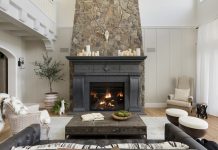
After traveling the globe and perusing countless architecture publications, the world’s largest potato farmer had decided: He wanted to live in an urban loft in an old warehouse. The Fargo-based businessman didn’t have to look far. A former commercial laundry, built in 1923 and long vacant at a busy intersection in downtown Fargo, was available.
Chris Hawley, principal of Chris Hawley Architects in Fargo, won the design commission and transformed the 19,000-square-foot, terracotta and brick behemoth into a three-level home, in large part by “treading lightly around all the features that were already there,” Hawley says. Those features include heavy timber construction, poured concrete floors, brick walls, loading-dock doors, an enormous front entrance (that had been blocked off), and the building’s existing raw finishes. Windows were replaced with tripled-glazed, low-E updates.
“We made our own rules,” the architect says of his approach to the project. “One rule was that we’d expose any column and beam connections—no matter where they showed up,” even if that meant cutting a hole in a drywall ceiling around a column. Another rule: “The client said that anywhere he’d be brushing his teeth, making food, or sleeping, he didn’t want any dirt falling on him. Old warehouses tend to be dusty, so in those locations we treated the ceiling so it wasn’t exposed.”
Hawley divided the structure into three zones with three purposes. The main or street level is the public area for entertaining. Here the architect inserted a long curved bar of steel, poured concrete, and Douglas fir; a wine storage room (repurposing some of the laundry’s old windows for walls); and sitting areas with a fireplace where the furniture can be easily moved for dancing. The first level also includes the “cedar room,” a lounge area in which a large-screen TV and speakers are embedded in a cedar-block surround, and a guest bedroom, bath, and kitchenette.

A custom zigzag steel stair leads to the second level, the family’s private quarters. Here Hawley peeled off a white bead-board ceiling—which he reused in a sunroom with a large hanger door on the first level—and sandblasted the white-painted brick to its natural color. The couple’s master suite is on one end of the second story; their two college-age sons each have a suite on the other end. In between is an open living area with kitchen, concrete-block pizza oven, dining table, and sitting area with a linear fireplace. The second-level deck has a corrugated metal roof, a sauna tucked behind the outdoor kitchen, a floor of cast-concrete pavers, and cedar planting boxes.
The lower level—site of the original loading dock and the boiler room—is the family’s gym. Hawley inserted a resistance pool for lap swimming into the floor and fitted the workout equipment between existing columns and mechanical equipment. A garage built in the 1980s houses a collection of classic cars.
“The design actually didn’t change from our first meeting to the completion of the project,” Hawley says. “The client didn’t want us to dance around the old building, but rather embrace it. And we did.” chrishawleyarchitects.com





















